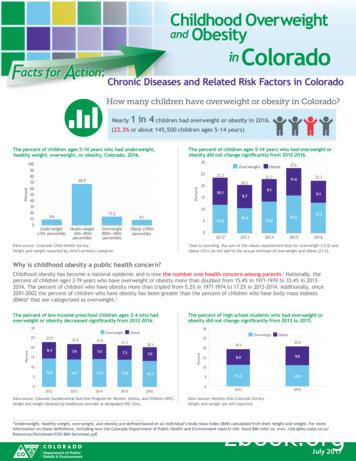Common Technology In Children With Medical Complexity
Usually a long tube is placed first, then can bechanged to button tube once stoma hasepithelialized Increased risk of bowel obstruction and stricture,peritonitis in immediate postoperative period Avoids gastric outlet obstruction with tube throughpylorus (as in GJT) Tend to leak more
Important Information about G/GJ/J Tubes Know type & size of tube, balloon volume Postoperatively: Feeds started quickly after surgery Usually start continuous feeds first, then smallboluses, then full boluses May place G portion of GJ tube to intermittentsuction for post-op gastroparesis Initial G tube change occurs in SurgeryClinic 6 weeks post-op Subsequent G tube changes are done athome Size changes are best done in SurgeryClinic (stock and supplies) Maintenance: Clean daily with soap and water, avoidhydrogen peroxide G tube should be able to move up anddown 1 cm and rotate 180 GJ tubes do not rotate much Check balloon volume and change tubemonthly (may depend on health plan and# tubes provided to patient per month) Flush tube with water after feeds andmedications Use liquid form of meds wheneverpossible
Troubleshooting G/GJ/J TubesDISLODGEMENT If within 6 weeks of initialplacement: Place Foley one size smaller, do notinflate balloon or feed Fluoroscopy to replace ASAP If after 6 weeks: Can replace at home or in office Place Foley of similar diameter,secure with tape on skin Check for gastric secretions then canrestart feedsOBSTRUCTION Allow 1-3 ml of warm H2O to dwellfor 20 minutes, then gently pushand pull carbonated soda, pancreatic enzyme,or papain have been shown to beineffective Use 60mL syringe for smallerFrench tubes (NG, JT) to avoidrupture with excess pressure (30mLsyringe is safe for GT) Do not use stylet - breaks valves Last resort is to replace tube
Farrell* Valve System lldecompression-valve-system/ For gastric decompressionduring feeding Farrell bag should be hung at thesame height as the feeding bag The Farrell Y-port should be at orbelow the level of the patient’sstomach
ENFit Enteral Feeding Connectors Ubiquitous connection system* cancause serious misconnections Enteral vascular Vascular or Enteral tracheal even a blood pressure cuff (air) toperipheral IV 2017 GEDSA (Global Enteral DeviceSupplier Association) summit Plans to change all enteral feedingtubing connections to the ENFit system World-wide, staggered ds/2016/09/ESPENPresentation.pdf
Resources https://www.feedingtubeawareness.org/ ENFit: 9/ESPENPresentation.pdf Singhal, et al. Tube Feeding in Children. Pediatrics in Review January2017, 38 (1) 23-34
CLOSING DISCUSSIONYes, we can but should we?
Illustrative Case 17 year old boy with Multiple admissions over thelast 2 years for respiratory HIE due to drowning event at 2yoinfections (twice to PICU) significant upper airwayobstructiondespite aggressive airwayclearance with bronchodilators, severe neuromuscular scoliosiswith significant contractureshypertonic saline, vest, and GERD and dysphagia s/p GT andnocturnal BiPAPNissen His GI provider has been severe malnutrition due tostruggling to find a feedingchronic feeding intoleranceregimen he will tolerate; pressure ulcers over multiple bonymeanwhile he has becomeprominencesseverely malnourished43
Illustrative Case Mom expresses concern becauseshe and the orthopedic surgeonhave been trying to coordinatespinal fusion surgery Mom has, in the past, refusedtracheostomy, and she does nothave an advance directive at themoment What are the risks of spinal fusionin the patient’s current state? Inability to extubate Prolonged recovery period requiringinpatient care Poor w
can cause mucous plugs) Optimize airway clearance measures: vest, cough assist, albuterol, hypertonic saline, ipratropium, acetylcysteine Accidental decannulation 1. Replace the same tube (if not obstructed) 2. Replace with the same-size back-up tube in the “To Go ag” 3. R
High Risk Groups of Children Street & working children Children of sex workers Abused, tortured and exploited children Children indulging in substance abuse Children affected by natural calamities, emergencies and man made disasters Children with disabilities Child beggars Children suffering from terminal/incurable disease Orphans, abandoned & destitute children
Obara (UCLA) Common Knowledge and Common Prior February 27, 2012 18 / 27. State Space Model, Common Knowledge and Common Prior Common Knowledge Theorem Event E is common knowledge at !2 (!2K1(E)) if and only if the
Children’s feelings about their experiences of talking to professionals 24 Some suggestions from research about the support services children might want 24 Respecting children’s agendas 25 How children would like to be involved 27 Successful ways of listening to children 28 Summary 29 . 4 Summary of the seminar on 5 July 1999 33 Children’s rights 33 Children’s right to information 34 .
87.0% of children ages 5-14 54.0% of children age 1-14 had 2 hours or less of screen time on weekend days 79.7% of children ages 1-4 years 45.1% of children ages 5-14 years Sleep17 More than three quarters of children meet recommendations 76.0% of children ages 1–14 years met age-specific sleep recommendations 81.0% of children ages 1–2 .
Children’s Books and Childhood 9. Children in the Middle Ages 9 Children in Puritan Times 9 ASK THE CRITIC . . . Betsy Hearne. 10 Children in the Enlightenment 11 The “Golden Age of Children’s Literature” 12 Contemporary Children’s Books 13. The Genres of Children’s
Impact of technology-facilitated abuse on children Professionals reported that technology facilitated abuse contributed to harmful impacts on children [s mental health (67% of cases involving technology-facilitated abuse of children), on the childs relationship with the non-abusive parent (59%) and on children [s routine activities (59%).
* 2.5.8 Children engaging in sport or playing * 2.5.21 Children with animals * 2.5.25 Other children, foetus A 2.5.17 Children seated, kneeling or on all fours A 2.5.18 Children drinking or eating A 2.5.19 Children crying A 2.5.20 Children with musical
Guideline Schedules for Weekly Support Payments Combined Weekly Adjusted Income One Child Two Children Three Children Four Children Five Children Six Children Seven Children Eight Children Maximum Spouse and Child (50%) 100 12 1























